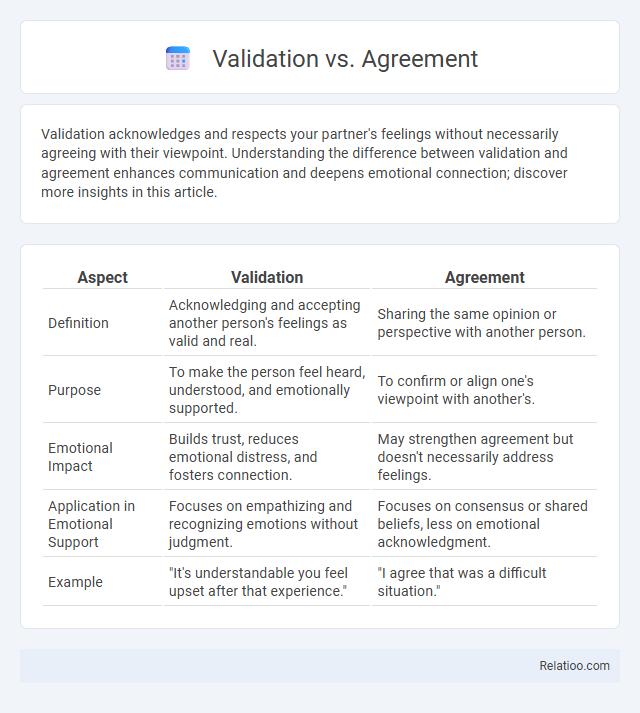Validation acknowledges and respects your partner's feelings without necessarily agreeing with their viewpoint. Understanding the difference between validation and agreement enhances communication and deepens emotional connection; discover more insights in this article.
Table of Comparison
| Aspect | Validation | Agreement |
|---|---|---|
| Definition | Acknowledging and accepting another person's feelings as valid and real. | Sharing the same opinion or perspective with another person. |
| Purpose | To make the person feel heard, understood, and emotionally supported. | To confirm or align one's viewpoint with another's. |
| Emotional Impact | Builds trust, reduces emotional distress, and fosters connection. | May strengthen agreement but doesn't necessarily address feelings. |
| Application in Emotional Support | Focuses on empathizing and recognizing emotions without judgment. | Focuses on consensus or shared beliefs, less on emotional acknowledgment. |
| Example | "It's understandable you feel upset after that experience." | "I agree that was a difficult situation." |
Understanding Validation and Agreement
Understanding validation involves recognizing and affirming your feelings and experiences without necessarily agreeing with them, fostering emotional support and connection. Agreement implies sharing the same viewpoint or belief, which may not always be required for effective communication or relationship-building. Differentiating between validation and agreement allows you to provide respectfulness by acknowledging another's perspective while maintaining your own stance.
Key Differences Between Validation and Agreement
Validation involves acknowledging and accepting another person's feelings or perspectives without necessarily sharing the same opinion, whereas agreement requires a shared opinion or belief on a specific matter. Respectfulness emphasizes treating others with consideration and politeness, independent of whether validation or agreement occurs. The key difference lies in validation fostering emotional support without consensus, while agreement entails mutual concurrence on ideas or viewpoints.
The Purpose of Validation in Communication
Validation in communication serves to acknowledge and affirm another person's feelings, thoughts, or experiences without judgment, fostering emotional connection and trust. It differs from agreement, which implies concurrence with someone's viewpoint, and from respectfulness, which involves treating others with courtesy and consideration regardless of differing opinions. The primary purpose of validation is to create a safe environment where individuals feel heard and understood, enhancing empathy and reducing defensiveness in interactions.
The Significance of Agreement in Interactions
Agreement in interactions enhances mutual understanding by aligning perspectives and reducing conflicts, fostering a collaborative environment. Unlike validation, which acknowledges feelings without necessarily sharing them, agreement signifies shared beliefs or conclusions that strengthen connections. Respectfulness maintains dignity and openness, but agreement specifically cultivates trust and reinforces commitment in communication.
Psychological Impact of Validation vs Agreement
Validation acknowledges and affirms an individual's feelings or experiences, fostering emotional safety and promoting psychological well-being by reducing feelings of isolation. Agreement, in contrast, merely aligns with someone's opinion or stance without necessarily acknowledging their emotions, which may leave underlying feelings unaddressed. Validation supports self-esteem and trust in relationships by encouraging authenticity, whereas agreement alone may fail to provide the emotional connection needed for mental health resilience.
When Validation Matters More Than Agreement
Validation matters more than agreement when emotional support and understanding are essential for effective communication and relationship building. It acknowledges another's feelings and experiences without requiring consensus, fostering trust and empathy in personal and professional interactions. Prioritizing validation over agreement reduces conflict and promotes open dialogue, especially in sensitive or contentious situations where validation affirms an individual's perspective.
Common Misconceptions About Validation and Agreement
Validation means acknowledging and understanding someone's feelings without necessarily agreeing with their viewpoint, while agreement implies full alignment with their opinions or decisions. Common misconceptions confuse validation with agreement, assuming you must share the same perspective to validate emotions, which limits authentic communication. Your ability to validate respects the other person's experience, fostering connection and trust without compromising your own stance.
How to Practice Validation Without Agreeing
Practicing validation without agreeing involves acknowledging another person's feelings or perspective as valid without necessarily endorsing their viewpoint or behavior; this can be achieved by using empathetic statements like "I hear that this situation is difficult for you" rather than affirming the content of their beliefs. It's essential to separate emotional validation from intellectual agreement by focusing on understanding and empathizing with the person's emotional experience while maintaining your own stance. This approach fosters respectful communication and supports healthy relationships without compromising personal integrity or promoting misunderstandings.
Benefits of Balancing Validation and Agreement
Balancing validation and agreement enhances effective communication by acknowledging others' feelings while fostering mutual understanding and collaboration. Validation reassures individuals that their emotions and perspectives are recognized, reducing defensiveness and building trust. Agreement, when combined with validation, strengthens relationships by finding common ground without sacrificing authenticity or respectfulness.
Practical Examples of Validation vs Agreement
Validation acknowledges and affirms Your feelings or experiences without requiring agreement, such as saying, "I understand that you're upset about the delay," even if you believe the delay was justified. Agreement involves sharing the same opinion or conclusion, like saying, "Yes, the delay was frustrating and should have been avoided," which aligns Your viewpoint with theirs. Practical validation supports emotional connection by recognizing emotions, whereas agreement aligns intellect and opinion.

Infographic: Validation vs Agreement
 relatioo.com
relatioo.com